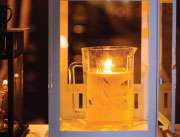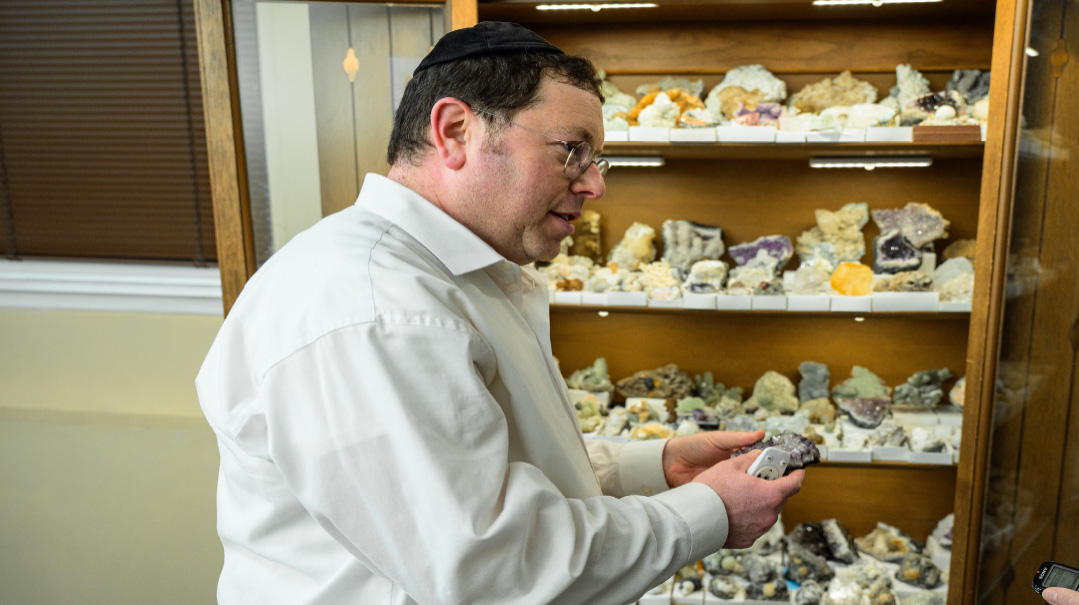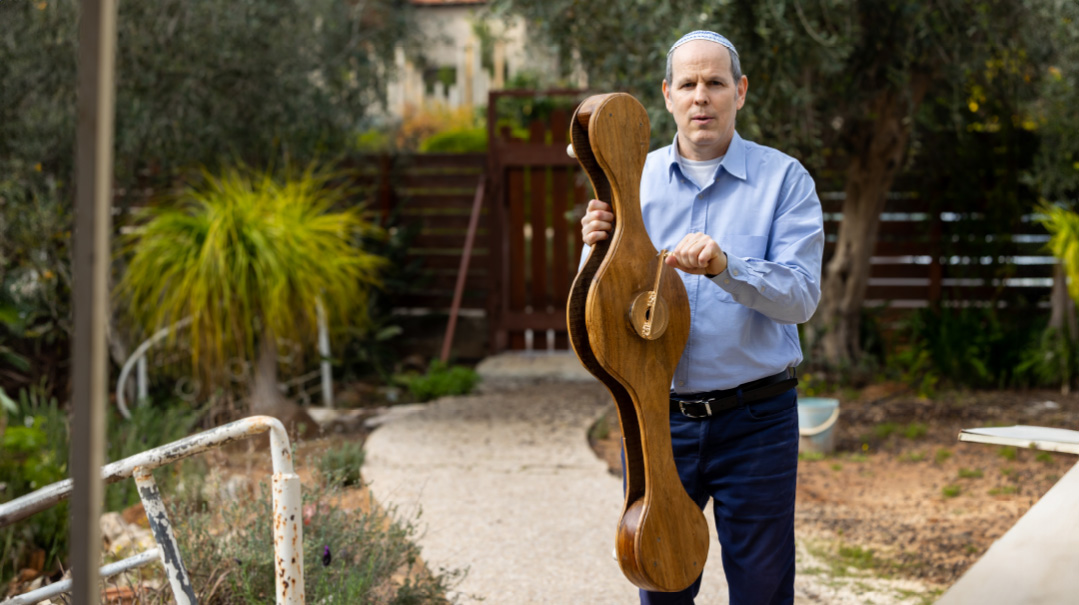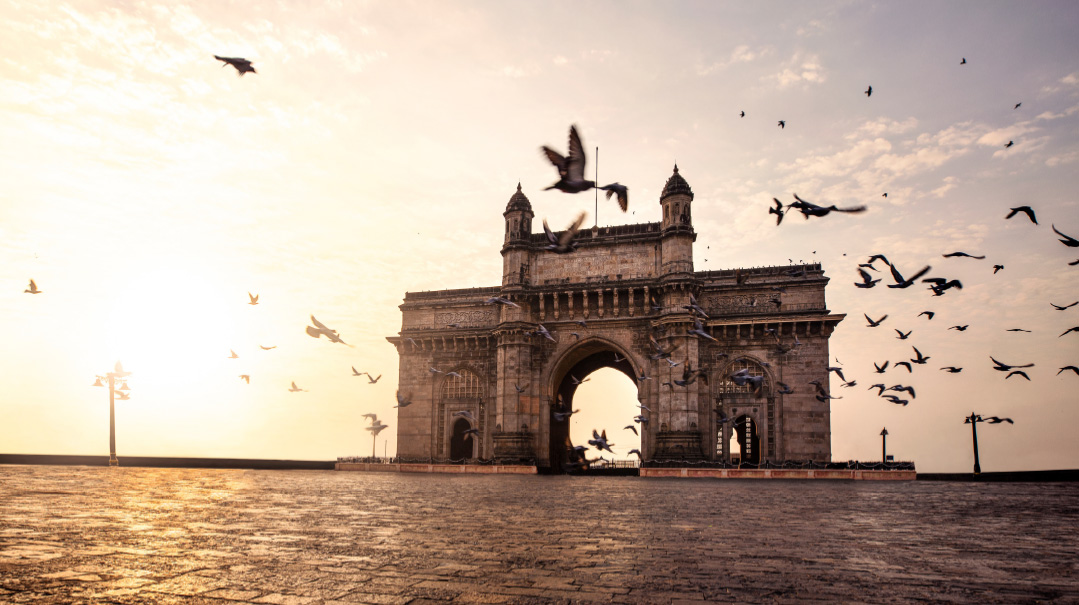The Right to Light


ENDURING ILLUMINATION Zeidy Kaufman wound up becoming part of the family and the rabbi’s surprise benefactor as well (Photos: Mayrav Zinnar)
W alk by 47 Nachal Ein Gedi in Ramat Beit Shemesh and you’ll see a menorah the likes of which you’ve surely never seen.
These neiros Chanukah stretch seven feet long and extend the length of an entire porch. It’s a display one would expect to find in the middle of a large city park not a small apartment at the end of a long lonely road.
The enormous chanukiah is the creation of Rabbi Avraham Levy the rav of Beit Haknesset Mishkan Eliyahu U’Malkah a Sephardic shul in the neighborhood.
“Every year I study the halachos of Chanukah and each year I try to see how I can be mehader this mitzvah” Rabbi Levy says. “That’s how I came up with the idea of using lanterns.”
Lanterns? Yes lanterns. The lanterns in question which line the porch ledge outside the Levys’ door are 11 inches high and 6 inches wide big enough to hold a cruse of oil that burns for 24 hours. “Rishonim say the neir Chanukah should burn as long as there are people in the shuk. In this neighborhood people are out all night so you need a lot of oil.”
The current setup allows the chanukiah to burn until the rabbi goes to Shacharis. “Sometimes they stay lit from Erev Shabbos until Motzaei Shabbos” Rabbi Levy says beaming.
Rabbi Levy is a bit of an expert in constructing extra-large menorahs. He mentions that lanterns are only his latest invention. “It was a fish tank before this” he says off-handedly. And slowly the intertwined story of Rabbi Levy’s quest for the perfect Chanukah lights and his return to Eretz Yisrael unfolds.
Fish Tank Fire
Avraham Levy was born in north Tel Aviv where lighting the menorah in the street is common practice. When he was 14 his father Rabbi Nissim Levy a Syrian Jew accepted a Jewish Agency position as rav of the Argentinean Sephardic community. Parnassah in Eretz Yisrael was always a struggle and the chutz l’Aretz salary was hard to pass up.
Rabbi Levy says it was difficult being an Orthodox Jew in Argentina where outward signs of Yiddishkeit are discouraged. “As a yeshivah bochur I walked in the streets with a kippah and the goyim there cursed and shouted at me.”
After four long years in Argentina Rabbi Levy’s father decided it was time to return home — but that was not yet meant to be. On the way to Eretz Yisrael the Levys stopped off in America for a short visit with relatives. While there a kehillah in need of a rav invited the Levys to stay. Parnassah was still a real consideration and Flatbush became another v’yisu vayachanu on Avraham Levy’s journey home. Although anti-Semitism in America did not compare to Argentina’s Chanukah still was not the same. There were no menorahs being lit outdoors. There was wind and snow to take into account. Besides lighting outside just wasn’t done in Flatbush.
After he married and took up a post at a little shul in Boro Park Rebbetzin Esther Levy reminisces Rabbi Levy still lit his menorah at the window. “He was worried the landlord wouldn’t like having a ‘fire hazard’ set up outside his home.”
It was only three years later when he became rav of Shaare Yeshuah M’Tzion aka the Sephardic Center of Mill Basin New York that he finally put pirsumei nissa back on display. “Our congregants were Israelis Sephardim who found affordable rent on the outskirts of the old Mill Basin community while we were in the heart of the neighborhood right next door to the shul. Our neighbors were old-timers with their American flags. But Chanukah time was when we saw which homes were Jewish — plug-in menorahs popped up in numerous windows of the surrounding homes. I saw then the power of the neiros. You might not see who goes to shul for Yizkor but you saw who had the light shining in the darkness.”
The traditional neighbors immediately got to know the rabbi with the unusual lighting display and lots of little children. “They didn’t join our minyan but we certainly made an impression on them” Rebbetzin Levy says.
The first Chanukah in Mill Basin the rabbi’s eldest son lit the menorah in the window at the side of the house while the rabbi made his way to the front stairs to light neiros Chanukah outside. His menorah innovation? A menorah in a fish tank.
“I kept asking my husband if we should bring a menorah from Israel after we tried to get a menorah made by a glazier who said ‘That’s impossible to make. You need tempered glass etc. etc.’ We had an empty fish tank lying around — but not for long.”
Rabbi Levy decided a fish tank would be perfect for the glass menorah-housing so common in Eretz Yisrael and vital for keeping neir Chanukah lit regardless of the elements. Fish tank in place the rav went in search of a glass menorah cup that could hold enough oil to burn for more than half an hour and withstand the heat. A box of newly purchased gold-embellished Moroccan-style tea cups caught his eye.
“I bought them for Pesach because they are exactly the shiur for the Seder but then my husband saw them” Rebbbetzin Levy grins ruefully. “Apparently they were perfect for Chanukah too. They didn’t even make it to one Yom Tov.”
Wind and rain in snowy New York demanded a larger tank. By the following year the new menorah tank was so large it had to be propped up by two dining room chairs placed side by side. For 12 years Rabbi Levy lit his large fish-tank menorah outside his door in the heart of Mill Basin. “Our house was right by a bus stop” the Rav says. “We would light the menorah I would sit outside with the children and sing and people would pass by and watch. Sometimes people waiting at the bus stop would come over and ask questions.”
“Everyone knew this was the rabbi’s house” the rebbetzin says. “Everyone knew he was the rabbi of the fish-tank menorah.”A Magical HugIt was a cold Chanukah evening. After the Rav finished lighting his menorah he took a stroll around the neighborhood. As he walked by a home decorated with Chanukah paraphernalia the Yemenite baal habayis saw him.

“Kevod HaRav” he said “We’re having a Chanukah party. Can you please come inside and light the chanukiah for us?” Although these were not members of the Rabbi Levy’s shul they knew him from his large and unique Chanukah display. Rabbi Levy immediately agreed. He lit the candles pulled the guests into a lively dance said a few words and then left. Months later the week before Tishah B’Av Rabbi Levy received a call from another local rabbi Rabbi Rappaport. “Please there’s a young convert who is suffering from a deep depression. He’s really not doing well and he’s desperately in need of chizuk.” Rabbi Levy invited the young man over to talk and after a lengthy conversation the Rav convinced him to come to his shul that Shabbos.
Shabbos Chazon. Friday night and Rabbi Levy looked around the shul. The ger had not shown up. Shabbos morning rolled around with no sign of him either.
At the Sephardic Center shul there is a special Shabbos minhag. After hagba’ah the sefer Torah is carried around the shul. The man holding the Torah is followed by the rabbi while all the shul’s children trail behind. As the Torah passes by each person leans in to kiss it and then shakes hands with the rabbi who wishes him Shabbat Shalom.
That Shabbos Chazon was much the same. Rabbi Levy walked around the shul looking for that particular face. As he neared the front of the shul again he saw him! The Rav took the boy’s hand and pulled him in for a tight bear hug. “Good Shabbos” the rav said warmly and gave him a slap on the back. Then Rabbi Levy realized something.
He had just hugged a complete stranger. This was not the person he had been looking for. Shabbos ended and that stranger showed up on the Rav’s doorstep. “Kevod HaRav” he cried. “I want to come back.”
“He was standing at my door” Rabbi Levy says “He looked like a complete hippie. He had on a ton of necklaces and his hair…” The rabbi motions to paint a picture of this boy with dreadlocks and all. “He was a dati Israeli who had gone off the derech and was living in Williamsburg with all types of colorful people many of them not even Jewish.”
The Rebbetzin supplies more details. “He was an airbrush artist staying in an artist’s loft next to the Brooklyn Bridge. You know those stalls in Kings Plaza? Well he ran one of them. That’s where he sold his T-shirts.”
What made this Jew ready to come home? The spark of light. The light of Chanukah. “You don’t remember me Kevod HaRav but I remember you” the boy said.
(Excerpted from Mishpacha, Issue 641)
Oops! We could not locate your form.







